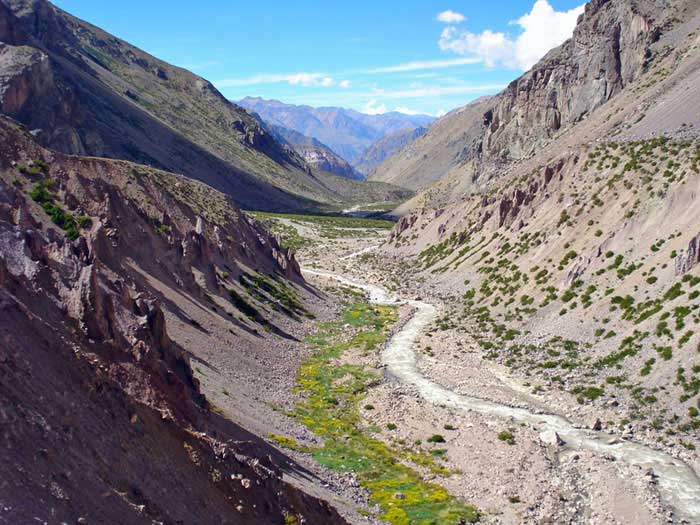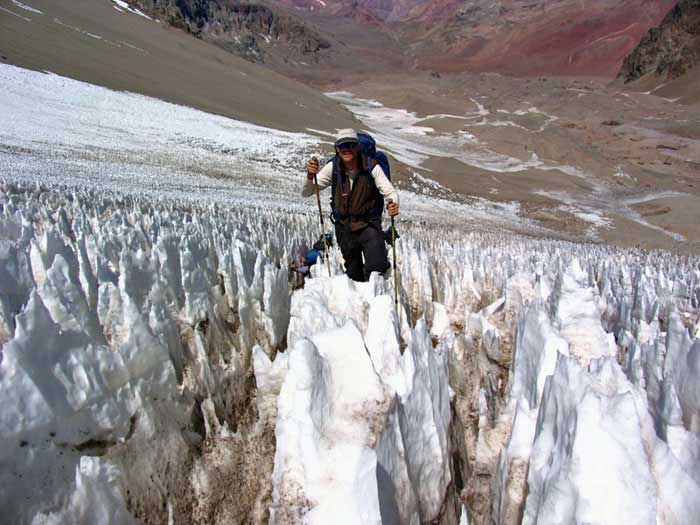Geography
-
To the north and east of Aconcagua is the Valle de las Vacas (“Cows Valley”) and to the south and west lies the Valle de los Horcones Inferior.The Cordillera de los Andes of which Aconcagua is a part of was created by the subduction of the Nazca Plate beneath the South American Plate during the geologically recent Andean orogeny (25 million years ago).This convergence is still occurring at around 95mm per year. This has resulted in a number of major earthquakes in the region, one in 1861 which completely destroyed Mendoza, and another in 1906 killed 20,000 people when it hit Valparaiso on the Chilean coastline measuring 8.6 on the Richter scale. The most recent earthquake hit both Valparaiso and Mendoza again in 1985 but the damage caused was nowhere near as significant.
- The height of Aconcagua is the result of this overall lifting of the Andes mountain chain. The entire mountain range is 70km wide southwards of the Diamante River and narrows northwards to 30km in the Park area. Heights also decrease from north to south from over 6000m to nearly 3500m. This wide variation between high and low ground is noticeably apparent on Aconcagua.
- The jagged appearance of the mountain contrasts with the smooth and flat river valleys below, where pointed mountain features blend into scree slopes that lead down to the rivers. The stark contrast between the high peaks and low valleys comes as a result of weathering processes over millions of years. Landslides are commonplace in this area.
- The Aconcagua landscape is definitively volcanic in appearance but the mountain is not actually a volcano unlike the nearby Tupungato (6570m) and Maipo (5264m). It is a high massif which finishes in two peaks: North and South, joined by a one kilometre long ridge known as the Cresto del Guanaco. Various ridges radiate from each summit and the whole massif is isolated from other high peaks. There are in fact, no less than thirteen 5000m plus peaks surrounding Aconcagua.
- The action of ice and low temperatures on Aconcagua have had an impact on the modelling of the landscape, causing deep glacial ravines and fractured rock formations. The variations in the landscapes here are wide ranging; with giant screes, vast slopes, large stone walls, hanging ice glaciers, moving snow fields and an imposing dark blue sky. In places such as these, the power of nature is infinitely displayed against the frailty of mankind.

Geology
-
The geology of the Andes range was first examined by Charles Darwin in 1835 who drew sketches of his findings which are still important today. The main rock found on Aconcagua is grey in appearance with black specks. Its texture is not dissimilar to sandstone but it has been identified as a volcanic andesite, indicating that Aconcagua may have been volcanic in the past.
- There are also brown, red, white and mottled rocks which reflect that Aconcagua is made up of several types of rock: base sedimentary rocks, volcanic rocks from the Tertiary Period, marine sediments from the Mesozoic era and glacial and alluvial deposits. The base sedimentary rocks date back 300 million years from as far back as the Carboniferous Period, and are oldest along the Vacas Valley (Polish Glacier) Route.
- Tectonic plate movements have raised and twisted these base sedimentary rocks so that fault lines and dramatic folds are common. Further rock fracturing due to the characteristics of a high altitude climate and the lack of vegetation has caused marked physical changes to the look of the area, especially due to the action of ice and low temperatures, with the ice playing a key part in modelling the Andean landscape
Glacial Formations
-
There are five main glaciers in the Aconcagua area which together cover an area of around 32km². Many of them are covered either by scree deposits or by penitentes, an interesting ice feature which have a distinctly spiky appearance. These spikes range in size but can be as big as 4m high, forming quite an obstacle for climbers crossing this unusual type of terrain.
- The Lower (Inferior) Horcones Glacier stands out and originates from the southern base of Aconcagua. The Polish or the Los Relinchos Glacier lies on the eastern flank of the mountain and is part of a well-known climbing route. Additional glaciers include the Upper Horcones Glacier, the Ventisqueros Güssfeldt Glacier and the Vacas Valley Glacier. In the past a series of important glaciers developed in the Confluencia area where huge ice bodies converged that were several kilometres originating from the Lower Horcones valley and the streams coming down from Tolosa (5450m).
- Glaciations in the main mountain range are not as extensive as those found in the Patagonian region as a result of predominantly arid conditions. The glaciers developed in the valleys, thus shaping high-mountain ice caps in the upper elevations, such as on Aconcagua (6962m), Nevado Juncal (6110m) and Cerro El Plomo (5424m). Comparatively, the moraine deposits left by the glacial forward and backward movements are not very large and are found in the main valleys and near the present glaciers.
- The remaining glaciers include: exposed glaciers, glaciers made only of ice, glaciers covered by detritus, which are glaciers undergoing a thinning process and whose inner rubble has come up to their surface. This covering layer acts like an active layer which can undergo independent movement. There are also other glacial formations present that are mostly made of rock.

Ecology
-
The Provincial Park reserve is in the High Andean province. Because it is an ecosystem of extreme elevation and low precipitation, the biodiversity is low. However, numerous plant and animal species call this region their home and what is living on Acongagua is very interesting, showing a remarkable adaptation to high altitude life. Animals are mostly found in the lower areas of the park where food and water are more readily available and where temperatures are more forgiving.
- The mammals that inhabit the Aconcagua Provincial Park (large herds of guanacos, predatory pumas and red foxes) are commonly more rounded in shape than their lower ground counterparts and all have dense layers of fur that keeps them warm. These larger creatures will migrate to lower levels during winter but in the case of mountain mice and other sedentary species such as lizards and toads, hibernation is the key to saving energy during wintertime and even in the summer months these animals only move about during the day. European hares are also abundant and are considered an exotic animal in this region.
- Among the reptiles the Andean toad is of particular interest as it indicates that the water on Aconcagua is very pure. There is also a diverse range of birdlife here, with sightings of very small birds like the Andean hummingbird, as well as larger ones such as hawks, condors and eagles. Sparrows and finches will visit base camps searching for food and the meadows, streams and rivers are populated by various waterfowl such as torrent ducks.
- The predominant vegetation is open pastures of huecú and coirones with limited areas of low trees, such as yellow leña, yareta and goat horn. In general, the vegetation adapts to endure low temperatures, poor soils and snow and wind storms, almost disappearing over 4000m in altitude. The stocky look of this sort of plant is part of its adaptation to high winds and little water. There are flatter areas where water accumulates and you see other kinds of vegetation that are able to endure long periods of soil freezing.
